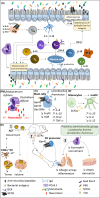AllergoOncology: Microbiota in allergy and cancer-A European Academy for Allergy and Clinical Immunology position paper
- PMID: 30636005
- PMCID: PMC6563061
- DOI: 10.1111/all.13718
AllergoOncology: Microbiota in allergy and cancer-A European Academy for Allergy and Clinical Immunology position paper
Abstract
The microbiota can play important roles in the development of human immunity and the establishment of immune homeostasis. Lifestyle factors including diet, hygiene, and exposure to viruses or bacteria, and medical interventions with antibiotics or anti-ulcer medications, regulate phylogenetic variability and the quality of cross talk between innate and adaptive immune cells via mucosal and skin epithelia. More recently, microbiota and their composition have been linked to protective effects for health. Imbalance, however, has been linked to immune-related diseases such as allergy and cancer, characterized by impaired, or exaggerated immune tolerance, respectively. In this AllergoOncology position paper, we focus on the increasing evidence defining the microbiota composition as a key determinant of immunity and immune tolerance, linked to the risk for the development of allergic and malignant diseases. We discuss novel insights into the role of microbiota in disease and patient responses to treatments in cancer and in allergy. These may highlight opportunities to improve patient outcomes with medical interventions supported through a restored microbiome.
Keywords: allergy; cancer; hygiene hypothesis; microbiota; oncoimmunology.
© 2019 The Authors. Allergy Published by John Wiley & Sons Ltd.
Conflict of interest statement
Dr Erika Jensen‐Jarolim is shareholder of Biomedical International R+D, Vienna, Austria. Dr Sophia N. Karagiannis is a founder and shareholder of IGEM Therapeutics Ltd. Dr Liam O'Mahony reports personal fees from Alimentary Health Ltd, grants from GSK, outside the submitted work. Dr Manuel L. Penichet is a shareholder of Klyss Biotech, Inc. The Regents of the University of California licensed Dr Penichet's technology to this firm. All other authors declare no conflicts of interest in relation to this publication.
Figures


References
-
- Arrieta MC, Stiemsma LT, Dimitriu PA, et al. Early infancy microbial and metabolic alterations affect risk of childhood asthma. Sci Transl Med. 2015;7:307ra152. - PubMed
Publication types
MeSH terms
Substances
Grants and funding
- R03 CA173842/CA/NCI NIH HHS/United States
- G0200486/MRC_/Medical Research Council/United Kingdom
- C30122/A15774/CRUK_/Cancer Research UK/United Kingdom
- G1000758/MRC_/Medical Research Council/United Kingdom
- C10355/A15587/BBC_/Breast Cancer Now/United Kingdom
- R01 CA196266/CA/NCI NIH HHS/United States
- MR/L023091/1/MRC_/Medical Research Council/United Kingdom
- G1100090/MRC_/Medical Research Council/United Kingdom
- G0501494/MRC_/Medical Research Council/United Kingdom
- R01 CA181115/CA/NCI NIH HHS/United States
- C30122/A11527/CRUK_/Cancer Research UK/United Kingdom

